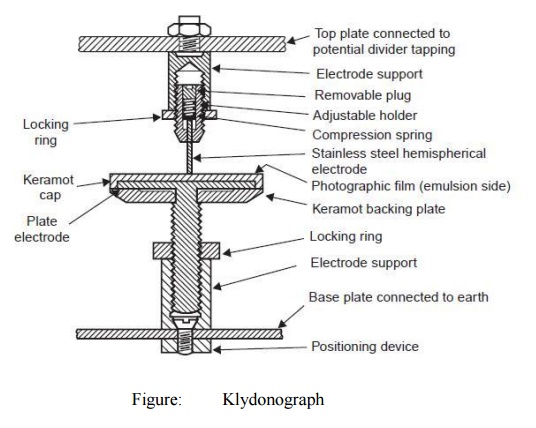Chapter: High Voltage Engineering : Measurement of High Voltage and High Currents
Klydonograph or Surge Recorder - Digital Techniques in High Voltage Measurement

Klydonograph or Surge Recorder
Since
lightning surges are infrequent and random in nature, it is necessary to
install a large number of recording devices to obtain a reasonable amount of
data regarding these surges produced on transmission lines and other
equipments. Some fairly simple devices have been developed for this purpose.
Klydonograph
is one such device which makes use of the patterns known as Lichtenberg Figure
which are produced on a photographic film by surface corona discharges. The
Klydonograph (Fig. 4.16) consists of a rounded electrode resting upon the emulsion
side of a photographic film or plate which is kept on the smooth surface of an
insulating material plate backed by a plate electrode. The minimum critical
voltage to produce a Figure is about 2 kV and the maximum Voltage that can be
recorded is about 20 kV, as at higher voltages spark over’s occurs which spoils
the film. The device can be used with a potential divider to measure higher
voltages and with a resistance shunt to measure impulse current. There are
characteristic differences between the Figure for positive and negative
voltages. However, for either polarity the radius of the Figure (if it is
symmetrical) or the maximum distance from the centre of the Figure to its
outside edge (if it is unsymmetrical) is a function only of the applied voltage.
The oscillatory voltages produce superimposed effects for each part of the
wave. Thus it is possible to know whether the wave is unidirectional or
oscillatory. Since the size of the Figure for positive polarity is larger, it
is preferable to use positive polarity Figure. This is particularly desirable
in case of measurement of surges on transmission lines or other such equipment
which are ordinarily operating on a.c. voltage and the alternating voltage
gives a black band along the centre of the film caused by superposition of
positive and negative Figure produced on each half cycle.

For each
surge voltage it is possible to obtain both positive and negative polarity
Figure by connecting pairs of electrodes in parallel, one pair with a high
voltage point and an earthed plate and the other pair with a high voltage plate
and an earthed point.
Klydonograph
being a simple and inexpensive device, a large number of elements can be used.
Related Topics